Advanced Research on Integrated Energy Systems (ARIES) is the U.S Department of Energy's research platform to validate our future integrated energy system with increasing renewables, storage, and loads at a size and scale that matters.


ARIES Vision
The ARIES vision is to validate a broad range of future energy systems and loads for various grid and industrial decarbonization scenarios, helping stakeholders accelerate the implementation of energy technologies needed to meet the U.S. goal of a carbon pollution-free power sector by 2035 and a net zero emissions economy by 2050.
Addressing an Urgent National Need
ARIES accelerates the ability to research and validate innovative solutions for large-scale integrated renewable generation, storage, and increasing demand-side loads—essential technologies to realize our national energy goals.
Developing an At-Scale Research Platform
ARIES is DOE's advanced research platform for energy systems integration research, validation, and demonstration at a scale that reflects the challenges faced by industry.
De-Risking Energy Systems
ARIES can replicate real-world scenarios of broad clean energy deployment, allowing users to safely demonstrate their best pathways to reaching local and national decarbonization goals.
Distinguishing National Asset
ARIES crosses multiple energy sectors, scales, and technologies. It joins together physical and virtual energy assets and enables national labs to combine their expertise and capabilities to address complex energy systems integration challenges.
ARIES Framework
Systems-level challenges drive the need for a research platform that could support integrated research, development, and demonstration at scale. ARIES focuses on solving three key challenges by addressing them through our strategic research areas: energy storage, future energy infrastructure, power electronics, cybersecurity, hybrid energy systems, and an emerging research area for Fiscal Year 2024, industrial decarbonization.
Key Challenges
Research Areas
2023 Impact
In 2023, ARIES made significant progress to address the three challenges and advance the platform's strategic research areas by:
2023 Numbers at a Glance
- AMMTO
- Advanced Materials & Manufacturing Technologies Office
- ARPA-E
- Advanced Research Projects Agency-Energy
- BTO
- Building Technologies Office
- CESER
- Office of Cybersecurity, Energy Security, and Emergency Response
- DOE
- U.S. Department of Energy
- EERE
- Office of Energy Efficiency and Renewable Energy
- FECM
- Office of Fossil Energy and Carbon Management
- FEMP
- Federal Energy Management Program
- GMI
- Grid Modernization Initiative
- GMLC
- Grid Modernization Laboratory Consortium
- HFTO
- Hydrogen and Fuel Cell Technologies Office
- NE
- Office of Nuclear Energy
- OE
- Office of Electricity
- OTT
- Office of Technology Transitions
- REGI
- Renewable Energy Grid Integration
- SC
- Office of Science
- SETO
- Solar Energy Technologies Office
- VTO
- Vehicle Technologies Office
- WETO
- Wind Energy Technologies Office
- WPTO
- Water Power Technologies Office
Learn more about the NREL facilities that make ARIES research possible:
Research Impacts
Technologies
Buildings
Hydrogen
Grid
Hydropower
Microgrid
Wind
Solar
Vehicles
Research Areas
Hybrid Energy Systems
Cybersecurity
Power Electronics
Energy Storage
Future Energy Infrastructure
Industrial Decarbonization
Integrated Energy Systems for Real-World Scenarios
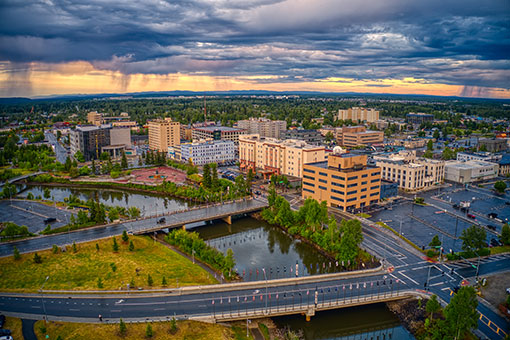

Fairbanks, Alaska Targets Transition Away From Coal With Help From Award-Winning ARIES Research
The U.S. Department of Energy launched the Clean Energy to Communities (C2C) program in 2023 to assist U.S. communities with their diverse clean energy goals and challenges. This support has been crucial for Fairbanks, Alaska, where electrical reliability issues are affecting residents with outages, emissions, and varying energy costs. Fairbanks received tailored technical guidance from NREL, including virtual system emulation with ARIES.
Using the ARIES software Simulation and Emulation for Advanced Systems (SEAS), NREL showed how large-scale wind power and a new battery energy storage system could be added to Fairbanks' grid to improve reliability and facilitate Fairbanks' retirement of its 50-MW coal plant and 20-year-old nickel-cadmium battery. SEAS allowed researchers to comprehensively model Fairbanks' proposed grid upgrades, including the possibility of an improved transmission line from areas with renewable generation. For this work, the SEAS software was awarded a coveted R&D 100 Award in 2023, and SEAS is poised to continue helping C2C cohorts by providing a clean energy sandbox to evaluate community energy plans.
Learn more about the award-winning SEAS software.
Sponsor: REGI
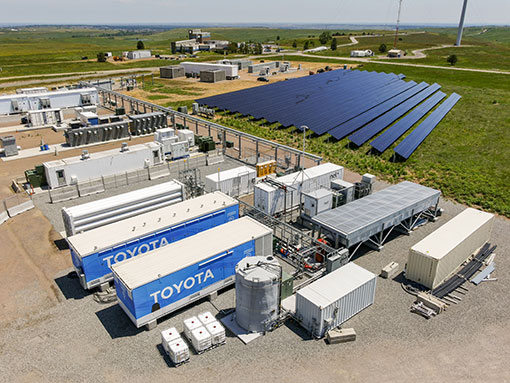
ARIES Proves How Hybrid Power Plants Can Operate in Energy Markets
FlexPower is a Grid Modernization Laboratory Consortium effort that combines the strengths of several DOE laboratories and funding offices to demonstrate hybrid plants using a full range of energy types, including pumped storage hydropower, ultracapacitors, nuclear, methane, hydrogen, kinetic storage, and more. The project team used ARIES to build physical hybrid plants with multiple energy types, design a controller for managing the resources, and deploy the hybrid plants against standard grid scenarios. Besides delivering unparalleled data around how hybrid systems can be integrated into current power systems, the team showed the value of hybrid plants to reduce the variability of renewable energy and increase their capacity factor.
A complementary study within FlexPower identified regions throughout the United States where such hybrid plants would be feasible. The final project work will connect all the lab results to show the benefits of hybrid plants in U.S. bulk grid applications for reducing emissions and providing reliable electricity.
Sponsors: GMLC project funded by WETO, HFTO, WPTO, and OE
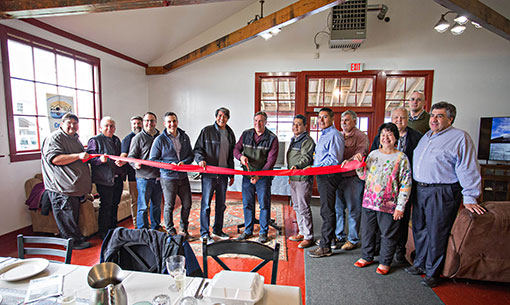
ARIES Digital Twin Leads to Resilient Microgrid Deployment in Alaska
The city of Cordova, Alaska, has modernized its microgrid resilience thanks to unparalleled capabilities within ARIES and funding support through the Grid Modernization Laboratory Consortium RADIANCE project. Cordova's new microgrid uses state-of-the-art metering and controls to optimally manage its hydropower generation, battery energy storage system, and unique electrical demand of the city's dominant fishing industry. DOE officials and project participants gathered in Cordova to celebrate and discuss the research breakthroughs, which include real-time data sharing from Cordova's microgrid to ARIES assets for risk-free system experimentation in a digital twin environment. This environment allowed Cordova and researchers to compare and review resilient operational strategies, and it has become part of the ARIES arsenal for remote system validation.
Learn more about the impacts of this microgrid project.
Sponsors: GMLC project funded by OE, WPTO
Solutions for Grid Stability
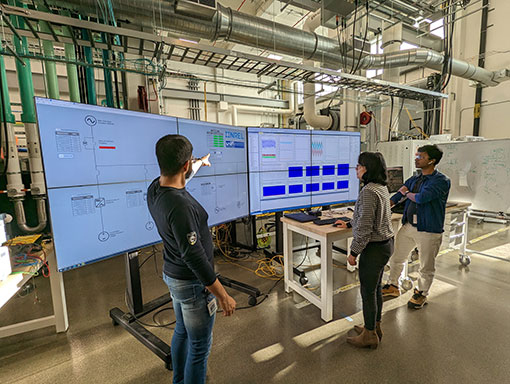
Universal Interoperability for Grid-Forming Inverters Consortium Advances Inverter Technologies to Support 100% Renewable Energy
As some systems approach 100% renewable energy, their stability hinges on the underlying technologies, especially the power inverters that interconnect many forms of renewable generation to the grid. The Universal Interoperability for Grid-Forming Inverters (UNIFI) consortium is a vast mixture of institutions that are combining efforts to advance grid-forming inverters—a necessary technological ingredient to operating renewable energy systems. Universal Interoperability for Grid-Forming Inverters partners are preparing for multimegawatt ARIES demonstrations with participation from grid-forming inverter vendors. The demonstrations will evaluate systems ranging from 50%–100% renewable energy and will validate specification documents drafted by the consortium. From the demonstrations, industry will have a clearer and more unified understanding of how to design future clean energy systems.
Sponsors: SETO, WETO
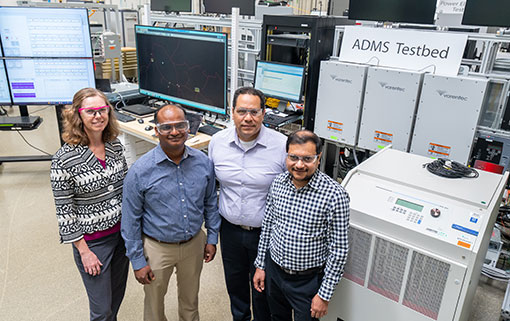

Utilities Implement Clean Energy Technologies Using Expanded Advanced Distribution Management System Research Platform
The Advanced Distribution Management System (ADMS) test bed allows utilities and companies to validate their grid solutions in emulated environments and, beginning this year, using all ARIES assets. Two ADMS projects launched this year with industry and utility partners: one studying the impact of virtual power plants on operations and another evaluating the use of advanced sensors for locating faults. The test bed was also used in DOE projects to demonstrate innovative grid controls, and it was the focus of a well-attended workshop with key partners. Following the 2023 user call, selected partners will use the test bed for vehicle-to-grid integration projects that will feature demonstrations on ARIES assets.
Find out more about the ADMS 2023 R&D award nominee.
Sponsor: OE
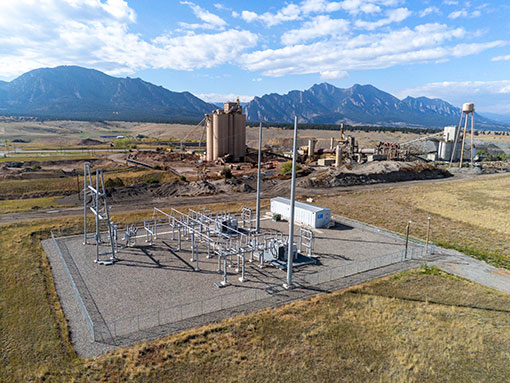

Dangerous Electrical Oscillations Are Identified and Avoided With ARIES Scan Tool
The Grid Impedance Scan Tool (GIST) can detect destabilizing interactions that arise in renewable power systems, and utilities and device manufacturers around the world are recognizing the importance of this ARIES-originated tool. Multimillion-dollar outages in Australia and the United Kingdom have been linked to electrical oscillations caused by wind and solar power plants, which also threaten to derail clean energy progress in many other locations targeting high levels of renewables. One such area, the island of Kauai, has relied on GIST to overcome emerging stability issues. As Kauai connected to ARIES using its authentic battery model, the GIST team injected a spectrum of electrical frequencies into the battery to scan its response, assuring the Kauai Island Utility Cooperative that their deployment could safely continue. GIST was a finalist for an R&D 100 Award in 2023 and continues to amass geographically broad interest from industry partners because of its uniqueness—there is no other tool with its full range of capabilities—and its technical importance to clean energy systems.
Learn more about NREL's GIST software and grid stability capabilities as a R&D100 finalist.
Sponsor: WETO
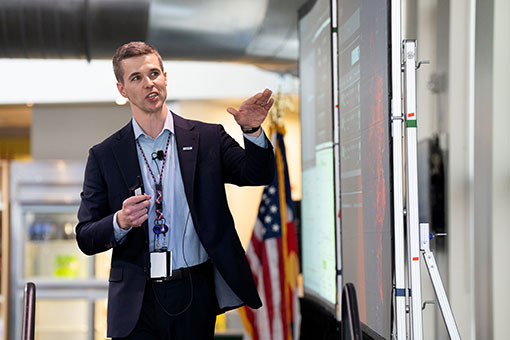
ARIES-Scale Demonstration Shows Government Offices What's at Stake in Cybersecurity
During an NREL cyber-resilience symposium for federal agencies, ARIES researchers, in coordination with eight other DOE national labs, performed a first-of-its-kind demonstration of potential impacts to grid reliability due to cyberattacks. The researchers showed a plausible multistage attack scenario on a virtual regional power system. The system included bulk power generation—including a wind power plant with a full-scale ARIES wind turbine as hardware-in-the-loop as well as other transmission, distribution, and grid-edge components. The symposium audience viewed the full attack sequence, moderated by the research team, and witnessed a live feed of the turbine blades slowing to a stop. The ARIES Cyber Range real-time visualization and simulation capabilities allowed the cyberattack demonstration to occur and helped important federal agency and office members grasp the importance of cyber resilience technologies in reducing cyber risk to future energy systems.
Sponsor: NREL
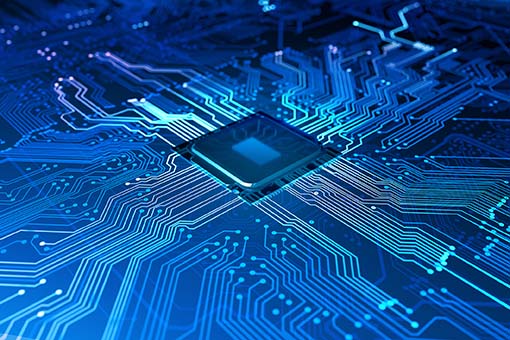
Disruptive Solid-State Converter Technologies Prototyped With ARIES
The electric grid could be transformed by an emerging power electronics technology—medium-voltage, silicon carbide, back-to-back converters—that enables two-way power flow and high precision control of distribution grid architectures. To prepare solid-state converters for the field, NREL and partner institutions prototyped two separate halves of a 330-kW device with ARIES power-hardware-in-the-loop. Researchers will next integrate the two halves into a single system for prototyping at full power and with realistic operations to verify the device's anticipated features. Such converters could allow grids to interconnect more distributed energy resources with less storage and to operate more adaptively during emergencies—playing a pivotal role in improving the reliability and security of our nation's electric grid.
Sponsor: AMMTO
Transformation With Future Energy Infrastructure
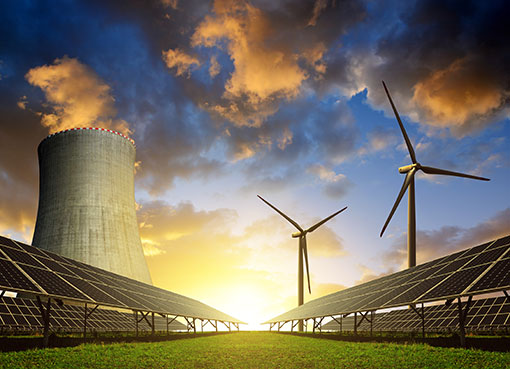
Nation-Spanning Data Network Leverages ARIES for Remote and Real-Time SuperLab
Somewhere between Golden, Colorado, and Idaho Falls, Idaho—and between reality and virtuality—an unlikely power plant that combined hydrogen, solar, battery, and nuclear resources operated for an hour. The unique power plant was the latest example of what can be accomplished with a DOE SuperLab, in which national laboratories connect their assets using the expansive Energy Sciences Network of data hubs. This demonstration was notable for being the first-ever proof of megawatt power experiments over ESnet. In doing so, the research team overcame technical challenges of latency despite extremely fast timescale communications. It was also an exceptionally unique power plant that could inspire future hybrid renewable energy options. With this achievement behind them, researchers now hope to build a super lab of 10,000 devices interacting across ARIES with other laboratories. This capability will allow users to address large energy integration challenges with the full force and scale of all DOE labs. Learn more about the SuperLab demonstration.
Sponsors: OE, NE, SC, HFTO
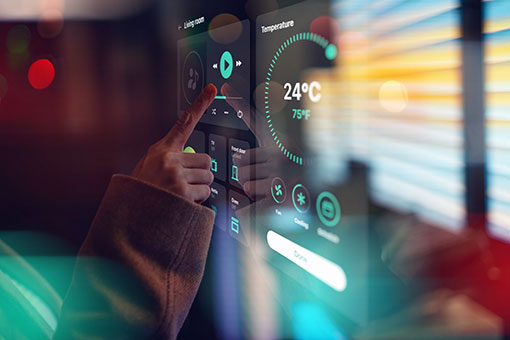
ARIES Provides Digital Twin Emulation for Cyber Defense of Buildings
An effort to implement cybersecurity into building control systems is using a recently updated ARIES capability to emulate cyberattacks and develop advanced defenses. The project, named Building Intelligence with Layered Defense using Security-Constrained Optimization and Security Risk Detection, offers a solution that protects smart buildings from cyber intrusions. It leverages buildings' network and physical data to identify attacks, and this year it was demonstrated on the ARIES Cyber Range using the building emulation tool Alfalfa and remote hardware-in-the-loop. The researchers used their findings to publish a first-ever data set documenting impacts from cyberattacks on buildings and distinguishing between attacks and mechanical faults. The ARIES building emulation capability will be central to a follow-on project, Emulation-Based Cyber Risk Assessment and Mitigation for Disadvantaged Communities.
Sponsors: BTO, CESER
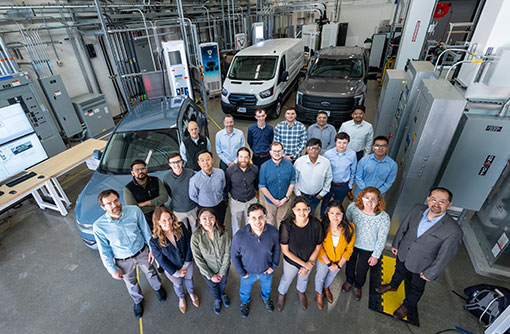
Electric Vehicle Growth Charges Ahead With ARIES Infrastructure
ARIES is supporting DOE's Electric Vehicles at Scale Lab Consortium with research and development platforms to address challenges and barriers for high-power electric charging infrastructure that enable greater safety, grid operation reliability, and consumer confidence. Alongside five national laboratories and key stakeholders, NREL's world-class ARIES facilities are a crucial resource for the multiyear collaboration's design and validation activities. ARIES capabilities enabled consortium researchers to characterize and quantify the charging profiles of high-power charging systems to improve control modeling and performance, develop a kilowatt-scale direct current (DC) charging hub platform that can integrate various DC-DC converters with a common DC distribution system, and develop 30 million daily travel itineraries that help identify energy needs and charging opportunities by outlining daily distances traveled, driving times, and dwell periods. The consortium's work ultimately accelerates the transition to electric fleets.
Sponsor: VTO

Lab Capabilities and Buildouts
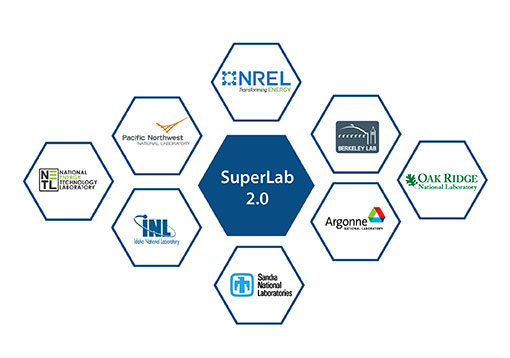
ARIES Connects Distant U.S. Department of Energy Capabilities Using Energy Sciences Network for Continent-Spanning Research
Developed in collaboration with EERE, FECM, NE, OE, and SC
The ESnet data network blurs the boundaries of ARIES by connecting it with other labs across the United States. ESnet now has exceedingly low latency, higher data capacity, and the architecture to virtually emulate power systems while concurrently using the very best U.S. research capabilities.
"Bringing together the complementary expertise of the national labs is what we do best—everyone brings their best game, and we all work together," said Eli Dart, Science Engagement Group lead at ESnet.
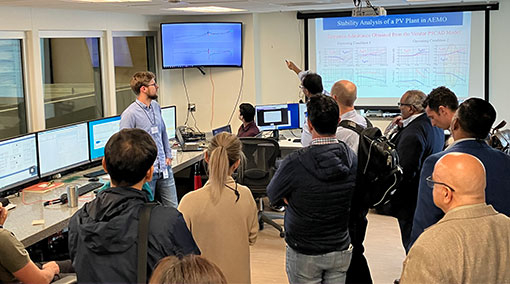
New Technologies in the Power Electronics Grid Interface Help Partners Design Stable Power Systems
Developed in collaboration with SETO and WETO
The Power Electronics Grid Interface (PEGI) is a plug-and-play space for partners to experiment with power technologies. PEGI provides controllability and measurement at very fast timescales of milliseconds, allowing researchers to study electrical interactions that are consequential for the safety of renewable power systems. Partners visited PEGI for a 2023 workshop, which stoked their interest in high-priority applications, such as analyzing the power stability of 100% renewable systems, made possible through the continued development of GIST. Read more about the PEGI collaborative workshop.
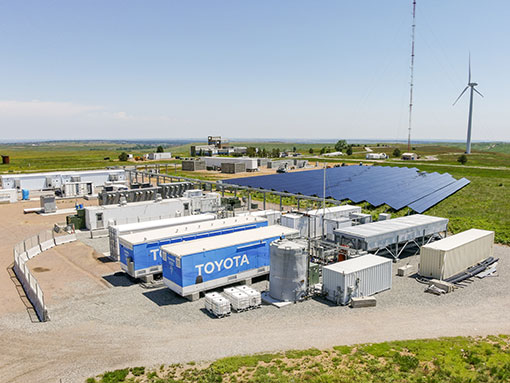
Flatirons Campus Buildout Adds New Strengths in Hydrogen and Large-System Emulation
Developed in collaboration with EERE
The Flatirons Campus hosts an impressive field of ARIES renewable energy infrastructure, and that infrastructure will soon be more versatile with the buildout of important hardware for clean energy solutions. Already underway, additions to the Flatirons Campus include a new controllable grid interface (CGI), a Control Center Facility, and visionary hydrogen storage and distribution. The CGI-2's 20-MW capacity more than doubles the power of its predecessor, enabling larger and more complex grid emulations, while the control center provides a much-needed facility for collaboration and campus operations. The hydrogen infrastructure will allow research on all aspects of utility-scale hydrogen deployment, including production, compression, distribution, and underground storage.
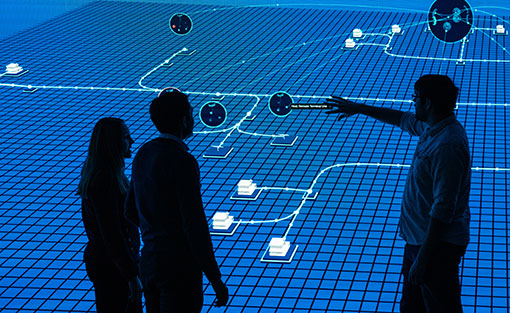
Cybersecurity Becomes One of ARIES' Fully Integrated Capabilities
Developed in collaboration with CESER and EERE
The ARIES Cyber Range capabilities have expanded in scope, scale, and fidelity to unlock cyber and physical research. Coupled with the wide range of hardware assets at ARIES, the cyber range provides a platform to study cyberattacks, cyber-resilience, and telecommunications as part of the transforming clean energy system. NREL's investment in expanding capabilities of the ARIES Cyber Range will continue through Fiscal Year 2024 and beyond.
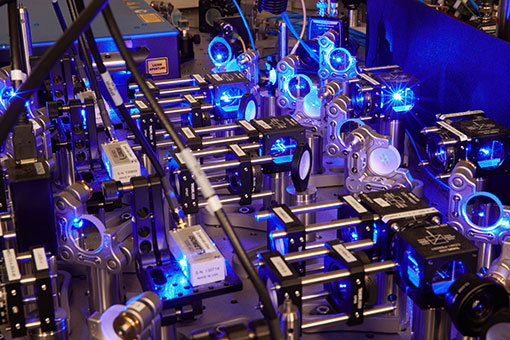
ARIES Adds Interface With Quantum Computers
Developed with support from EERE, OTT, Atom Computing, and RTDS Technologies, Inc.
ARIES researchers designed an interface for quantum computers to communicate with power devices in-the-loop, allowing experiments with an early-stage technology in a potentially disruptive application.
"Consider some of the most challenging problems in energy systems today: making decisions based on large sensor networks, optimizing system recovery during fault conditions, securing communications between network devices. There are core applications that quantum computers may excel at, so we're accelerating their adoption in power systems with this interface," said Rob Hovsapian, an ARIES senior researcher at NREL. Learn more about this interface for quantum computers.
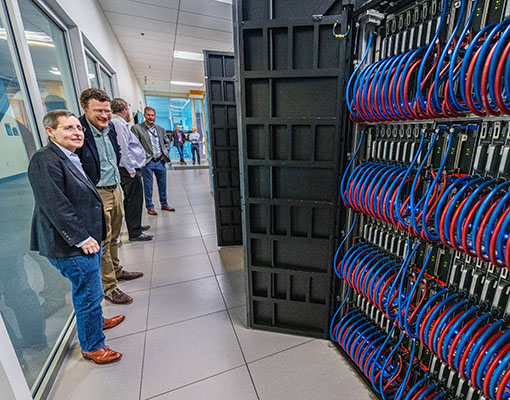
Supercomputer Kestrel Takes Flight With Substantial Increase in Computing Power
Developed in collaboration with Hewlett Packard Enterprise and EERE
Kestrel was installed this summer and began operations on time for the start of the new fiscal year in October. At five times the computing power of its predecessor, Kestrel is a central asset for complex grid simulations in ARIES.
"Kestrel represents a new capability for us to do better science faster. There's an awful lot of research problems that just need more GPU [graphics processing units] power to make progress," said Aaron Andersen, Kestrel engineering lead at NREL.
Researchers raised the bar in Fiscal Year 2023 with yet another high-flow record, heavy-duty hydrogen filling milestone—82.5 kg hydrogen fueling in 6 minutes. The previous record was 78.7 kg in Fiscal Year 2022.
Engagement and Outreach

NREL hosted more than 10,000 visitors from communities, industry, government, and academia to tour ARIES capabilities at the ESIF and Flatirons Campus in Fiscal Year 2023. Engagement and outreach highlights include:
- Hosting and introducing ARIES capabilities to U.S. government leaders and dignitaries from around the world, including U.S. Secretary of Energy Jennifer Granholm and other DOE executive leadership, Colorado Governor Jared Polis and other state staff, a Colorado senator, congressional staff, and executive leadership from other federal agencies, industry leaders, international ministers, and local officials
- Meeting and consulting with the external advisory board, comprising 13 members with utility, industry, academic, and governmental perspectives
- Presenting ARIES capabilities at various energy conferences and regional/community events, including NREL's seventh annual Partner Forum, where Robert Horton from Dallas Fort Worth International (DFW) Airport spoke about the airport's experience in planning its energy transition using ARIES assets
- Collaborating with national labs:
- Hosting national lab executive leadership and technical researchers
- Connecting research capabilities and assets with other national laboratories.
- Engaging with communities to support their energy transition strategies
- Convening industry leaders and NREL experts in three NREL-hosted workshops focused on the ADMS test bed, PEGI, and autonomous energy systems
- Gathering representatives from DOE, NREL, the National Rural Electric Cooperative Association, and other DOE laboratories in Cordova, Alaska, to celebrate the success and witness the real results of their effort on RADIANCE
- Celebrating 10 years of the ESIF—a key facility that makes ARIES research possible
- Engaging with the media with news stories that received over 108 million in potential reach and covered in outlets like Forbes, Axios, Popular Mechanics, and Scientific American.
Research Outcomes
The ARIES non-DOE partner portfolio grew 10% from Fiscal Year 2022.
Looking Ahead
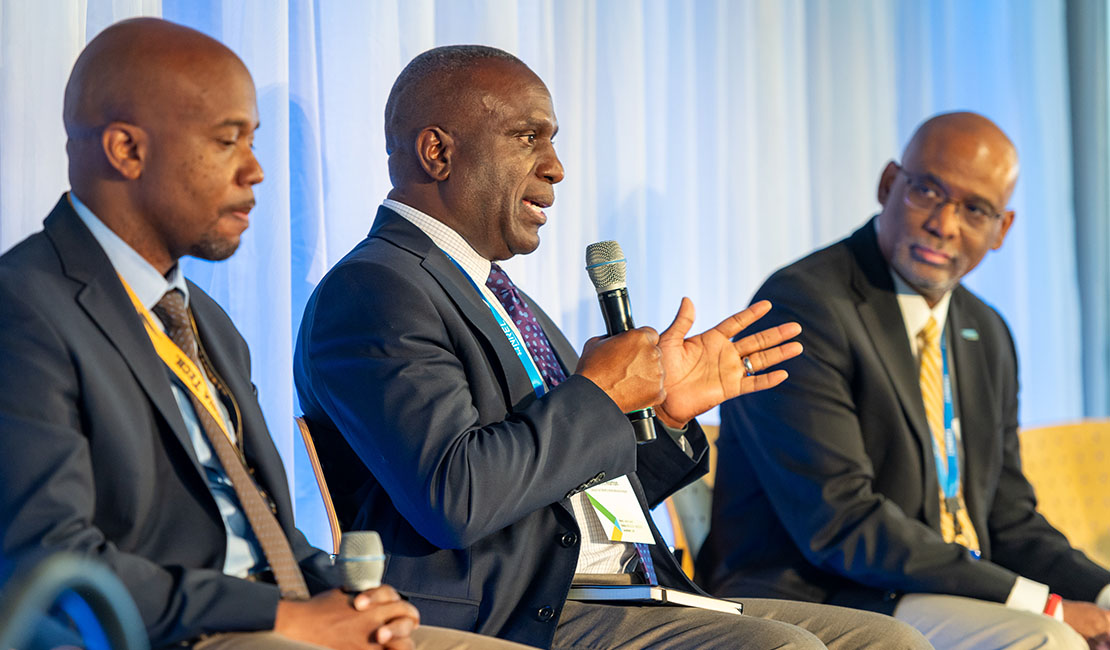
A 100% renewable energy future is possible and resilience is an urgent necessity, but the particulars of how we'll get there are still being filled in by enterprising groups confronting uncertainties head on. ARIES is their vehicle to comprehensively design and validate their desired energy systems—from fully decarbonized industrial plants to entirely electrified campuses. The future impact of ARIES is certain: wider collaboration, in-depth assistance to burdened communities, and technological innovation to reach new levels of renewable energy.
Local Support
ARIES has unique assets for community-scale transitions, and upcoming projects will put those assets to work in service of underrepresented communities. Research environments for networked microgrids—a 2023 R&D 100 Award winner—and digital twins for system planning are some tools that ARIES will provide to small U.S. communities as part of the next cohort in the DOE C2C program. Through C2C and other DOE programs, local communities will lead their own energy investments using ARIES for impartial evaluations along the way.
Wide-Impact Collaborations
ARIES offers common ground for industries, cities, or stakeholders to work together and standardize their solutions. This is what drives major collaborations, such as transit hubs mobilizing around Dallas Fort Worth International Airport's energy transition to learn and apply similar ARIES findings to their own efforts. Even deeper collaboration is on the way with the construction of the Global Energy (GLO) Park, an energy innovation business complex adjacent to NREL, and the launch of DOE's Energy Threat Analysis Center, a nationwide partnership to share threat information and strategies for securing the nation's critical energy infrastructure. ARIES will be in the middle of these alliances and more.
Technological Leadership
The diverse validation environments of ARIES make technological innovation possible across many domains. Planned expansions to hydrogen, vehicle, communications, and grid capabilities, among others, will enable demonstrations of next-generation energy technology breakthroughs. Long-duration energy storage projects sponsored by the DOE Office of Clean Energy Demonstrations indicate where ARIES could be especially useful in the near term, while newly slated projects in the Grid Modernization Initiative show the importance of ARIES for developing grid solutions of top national priority.
ARIES is also influential in designing solutions for hard-to-decarbonize industrial systems. NREL has led analysis on the technological feasibility of carbon-free operations, and now partners are putting solutions to the test at sites like remote mines and chemical processing plants. These same partners, among others, are now looking to ARIES for its unique scale and technological diversity to solve large decarbonization challenges.
Looking ahead, a research ecosystem is building around ARIES, and partners are realizing how far this new platform can take them toward finding innovative energy solutions at scale. Enabled by upcoming expansions, ARIES is emerging as the transformational tool that can unite and unlock our clean energy aspirations.
NREL works with organizations—large and small—to expand the clean energy economy. You can partner with ARIES to accelerate renewable energy and energy-efficient solutions into practical applications. Visit the ARIES webpage for opportunities to work with us or email us at [email protected] to discuss your project.
Advisory Committees
ARIES Steering Committee
The ARIES steering committee comprises DOE EERE and NREL executive leadership. This committee meets biannually and has oversight of and responsibility for ARIES research and development management, research impact, and financial and business practices.
Alejandro Moreno
Acting Principal Deputy Assistant Secretary, Office of Energy Efficiency and Renewable
Energy
Michael Berube
Deputy Assistant Secretary, Sustainable Transportation
Carolyn Snyder
Deputy Assistant Secretary for Buildings and Industry
Becca Jones-Albertus
Acting Deputy Assistant Secretary for Renewable Energy
Christy Cooper
Deputy Assistant Secretary for Operations
Kevin Lynn
ARIES Lead and Director of Grid Modernization
Derek Passarelli
Golden Field Office Director
ARIES External Advisory Board
The ARIES external advisory board provides an external perspective from industry, academia, and other government agencies/programs to NREL, DOE, and EERE on the research direction; research, development, and demonstration gaps that ARIES should address; and the development and deployment of the ARIES research platform.
Chair: Gary Smyth
Executive Director, Global R&D Laboratories
General Motors (retired)
Jeffrey Baumgartner
Senior Advisor
Berkshire Hathaway Energy
Colton Ching
Senior Vice President, Planning and Technology
Hawaiian Electric Company
Lauren Faber O'Connor
Operating Partner
Lowercarbon Capital
Paula R. Glover
President
Alliance to Save Energy
Christopher Herbst
Vice President, Strategic Partnerships and Innovation
Eaton
Robert Horton
Vice President, Environmental Affairs
DFW Airport
Alice K. Jackson
Senior Vice President, System Strategy and Chief Planning Officer
Xcel Energy
Danielle W. Merfeld
Chief Technology Officer
QCells
Teresa R. Pohlman
Executive Director, Sustainability and Environmental Programs
U.S. Department of Homeland Security
Ronald M. Sega
Representative
U.S. Department of Defense
Timothy D. Unruh
Executive Director
National Association of Energy Service Companies
Evan Wolff
Partner
Crowell and Moring LLP
NREL ARIES Team
Peter Green
Deputy Laboratory Director-Science and Technology
Johney Green
Associate Laboratory Director
Juan Torres
Associate Laboratory Director
Jennifer Kurtz
ARIES Research Director and Center Director
Jerry Davis
ESIF and ARIES Laboratory Program Manager
Jennifer Palmer
ARIES Research Advisor and Technical Coordinator
Rob Hovsapian
Senior ARIES Research Advisor
Special thanks to:
Daniel Laird, Matt Keyser, Barry Mather, Dane Christensen, Matt Thornton, and Steve Hammond
Laboratory program managers, operations team, communications leads, executive assistants, project managers, partnerships development team, finance leads, and subject matter experts.
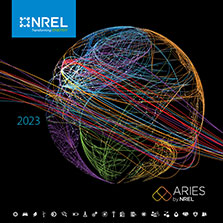
Share
Last Updated April 21, 2025
